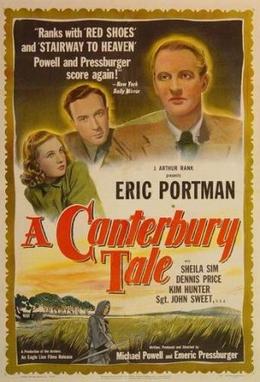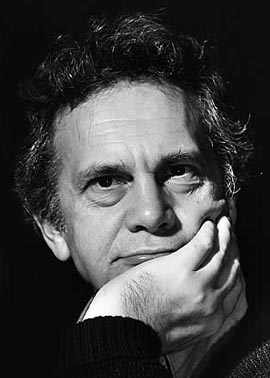
Raymond Hart Massey was a Canadian actor, known for his commanding, stage-trained voice. For his lead role in Abe Lincoln in Illinois (1940), Massey was nominated for the Academy Award for Best Actor. He reprised his role as Lincoln on television and in How the West Was Won (1962). Among his other well-known roles were Dr. Gillespie in the NBC television series Dr. Kildare (1961–1966), John Brown in Santa Fe Trail (1940) and Seven Angry Men (1955), Abraham Farlan in A Matter of Life and Death (1946), and Jonathan Brewster in Arsenic and Old Lace (1944).

Michael Latham Powell was an English filmmaker, celebrated for his partnership with Emeric Pressburger. Through their production company The Archers, they together wrote, produced and directed a series of classic British films, notably The Life and Death of Colonel Blimp (1943), A Canterbury Tale (1944), I Know Where I'm Going! (1945), A Matter of Life and Death, Black Narcissus (1947), The Red Shoes (1948) and The Tales of Hoffmann (1951).

A Canterbury Tale is a 1944 British film by Michael Powell and Emeric Pressburger starring Eric Portman, Sheila Sim, Dennis Price and Sgt. John Sweet; Esmond Knight provided narration and played two small roles. For the post-war American release, Raymond Massey narrated and Kim Hunter was added to the film. The film was made in black and white, and was the first of two collaborations between Powell and Pressburger and cinematographer Erwin Hillier.

Daniel Raymond Massey was an English actor and performer. He is possibly best known for his starring role in the British TV drama The Roads to Freedom, as Daniel, alongside Michael Bryant. He is also known for his role in the 1968 American film Star!, as Noël Coward, for which he won a Golden Globe Award and an Oscar nomination.

Emeric Pressburger was a Hungarian-British screenwriter, film director, and producer. He is best known for his series of film collaborations with Michael Powell, in a collaboration partnership known as the Archers, and produced a series of films, including 49th Parallel, The Life and Death of Colonel Blimp (1943), A Matter of Life and Death, Black Narcissus (1947), The Red Shoes (1948), and The Tales of Hoffmann (1951).

Trooping the Colour is a ceremonial event performed every year on Horse Guards Parade in London, United Kingdom, by regiments of Household Division, to celebrate the official birthday of the British sovereign. It is also known as the Sovereign's Birthday Parade. Similar events are held in other countries of the Commonwealth. In the UK, it is, with the State Opening of Parliament, the biggest event of the ceremonial calendar, and watched by millions on TV and on the streets of London.

The Welsh Guards, part of the Guards Division, is one of the Foot Guards regiments of the British Army. It was founded in 1915 as a single-battalion regiment, during the First World War, by Royal Warrant of George V. Shortly after the regiment's formation, it was deployed to France where it took part in the fighting on the Western Front until the end of the war in November 1918. During the inter-war years, the regiment undertook garrison duties in the United Kingdom, except between 1929 and 1930 when it deployed to Egypt, and late 1939 when it deployed to Gibraltar.

A Matter of Life and Death is a 1946 British fantasy-romance film set in England during World War II.

The Governor General's Horse Guards is an armoured cavalry regiment in the Primary Reserve of the Canadian Army. The regiment is part of 4th Canadian Division's 32 Canadian Brigade Group and is based in Toronto, Ontario. It is the most senior reserve regiment in Canada, and the only household cavalry regiment of Canada's three household units.

TheLife Guards (LG) is the most senior regiment of the British Army and part of the Household Cavalry, along with The Blues and Royals.

The British film-making partnership of Michael Powell (1905–1990) and Emeric Pressburger (1902–1988)—together often known as The Archers, the name of their production company—made a series of influential films in the 1940s and 1950s. Their collaborations—24 films between 1939 and 1972—were mainly derived from original stories by Pressburger with the script written by both Pressburger and Powell. Powell did most of the directing while Pressburger did most of the work of the producer and also assisted with the editing, especially the way the music was used. Unusually, the pair shared a writer-director-producer credit for most of their films. The best-known of these are The Life and Death of Colonel Blimp (1943), A Canterbury Tale (1944), I Know Where I'm Going! (1945), A Matter of Life and Death (1946), Black Narcissus (1947), The Red Shoes (1948), and The Tales of Hoffmann (1951).

Contraband is a 1940 wartime spy film by the British director-writer team of Michael Powell and Emeric Pressburger, which reunited stars Conrad Veidt and Valerie Hobson after their earlier appearance in The Spy in Black the previous year. On this occasion, Veidt plays a hero, something he did not do very often, and there is also an early (uncredited) performance by Leo Genn.

The Canadian Guards was an infantry regiment of the Canadian Army that served in the same role as the five regiments of foot guards in the British Army. The regiment was formed on 16 October 1953, by Lieutenant-General Guy Simonds, the Chief of the General Staff of the Canadian Army, with the redesignation of four separate battalions:

"The British Grenadiers" is a traditional marching song of British and Commonwealth military units whose badge of identification features a grenade, the tune of which dates from the 17th century. It is the regimental quick march of the Royal Artillery, the Corps of Royal Engineers, the Honourable Artillery Company, the Grenadier Guards, and the Royal Regiment of Fusiliers. It is also an authorized march of the Royal Australian Artillery, the Royal Gibraltar Regiment, the Royal Regiment of Canadian Artillery, the Canadian Grenadier Guards, the Royal Regiment of Canada, and the Princess Louise Fusiliers. The standard orchestration for the military band was approved in 1762, when the Royal Artillery Band became recognized officially, and for all other "grenade" regiments in 1763, when the remaining unofficial bands gained official status.

The Grenadier Guards is the most senior infantry regiment of the British Army, being at the top of the Infantry Order of Precedence. It can trace its lineage back to 1656 when Lord Wentworth's Regiment was raised in Bruges to protect the exiled Charles II. In 1665, this regiment was combined with John Russell's Regiment of Guards to form the current regiment, known as the 1st Regiment of Foot Guards. Since then, the regiment has filled both a ceremonial and protective role as well as an operational one. In 1900, the regiment provided a cadre of personnel to form the Irish Guards; while later, in 1915 it also provided the basis of the Welsh Guards upon their formation.

The London Guards is a formation within the British Army comprising the reserve companies of the Grenadier, Coldstream, Scots and Irish Guards. On formation these companies drew their personnel from the London Regiment and it traces its history back to the formation of that regiment in 1908 when 26 separate Volunteer Force battalions were brought together. The London Guards is not a regiment, the companies wear the uniform, and follow the traditions, of their foot guards regiment.

The Governor General's Foot Guards Band is an authorized Canadian Forces 35-piece brass and reed band. It consists of serving members of the CAF who parade on a part-time basis. It serves as the regimental band of the Governor General's Foot Guards (GGFG) and is the most senior band of the Canadian Army Primary Reserve.

The Bands of the Household Division refer to the grouping of the seven military bands of the Household Division, which forms a part of the British Army's London District. The bands belong to five regiments of foot guards and two Household Cavalry regiments.

The 2023 Trooping the Colour was held on 17 June 2023. Over 1,500 soldiers, 300 horses, and 400 musicians took part in the ceremony, the first to be held during King Charles III's reign, and for his first Official Birthday.

















